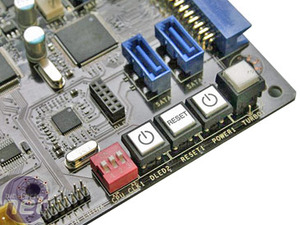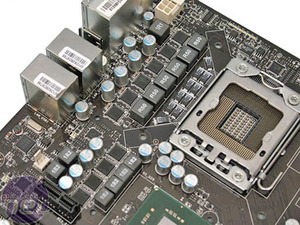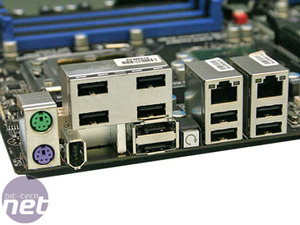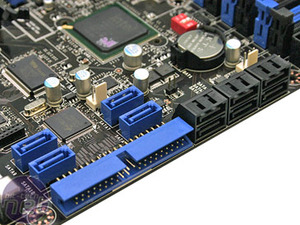Other niche features include ten SATA ports - six from the ICH10R southbridge and four from a pair of Micron JMB322 SATA chipsets. The SATA ports appear to be positioned so they don't get in the way of long graphics cards, so all sockets should still be useful when you're CrossFiring it up.
Two eSATA ports that are powered by the JMicron JMB363 chipset that also provides the single IDE channel, are featured on the rear I/O, as well as eight USB 2.0 (with twelve in total), a reset CMOS button, dual Gigabit Ethernet (Realtek RTL8111C) and VIA VT6308P Firewire with one 6-pin socket here and one pin-out on the board. The two PCI-Express 2.0 x16 slots are in black for CrossFireX, and there's a third x16 slot (which we assume is at x8 bandwidth) at the very bottom for a third card.
This leaves enough space between the graphics slots for dual height cards as well as a spare PCI and PCI-Express x1 slot, which is the better benefit, but it does mean that a card in the bottom slot will simply vacuum the bottom of your case.
Near the bottom there are four buttons - the usual two for power and reset but there's also an as yet undocumented "Turbo" button and the DLED2 button with an eleven holed socket labelled the same just above it. Are MSI going down the same route as Asus and providing a dongle for POST descriptions as an extra? Is the turbo button so you can boot the board at one speed, then kick it up a notch to a pre-set value as you reach the OS? Only time will tell.
Another improvement over P45, although somewhat of an unused feature, was the jumpers to change the frontside bus. These jumpers are thankfully far better positioned now - one is labelled CPU clock and the other QPI, however we're still going to question whether going backwards (Oooh, retro) is what people really want.
On one side we could argue why do people request onboard buttons if they aren't prepared to use onboard switches? Yet, outside of extreme overclockers and testers like ourselves, how many people really fish in their cases once they've built a system to flick some switches for overclocking - it's all BIOS level now.
Creative's X-Fi (PCI-Express, we assume) will be bundled along with this to cement the gaming angle of things. Since Gigabyte now offers full Dolby Home Theatre and Asus the equivalent DTS options, it seems a logical choice for MSI to continue following the Creative fold for something different. However, does the Creative software offer the same feature support and quality of Dolby and DTS? We'll be sure to check when we come to review it.
Finally, we've no idea of the cooling or bundle yet, so we'll have to wait and see what MSI comes up with to pimp out the latest product line. How well does this appeal compared to the Asus P6T we previously had an early look at? Do SAS and ExpressGate really present desirable and useful features for the masses, or does simply having more SATA and acute power efficiency offer a better choice?
Whatever your thoughts are, drop them into the forums and let us know your reactions since we need pass the time until we get the actual board in our hands for a full review! (Hint hint, MSI!)
Two eSATA ports that are powered by the JMicron JMB363 chipset that also provides the single IDE channel, are featured on the rear I/O, as well as eight USB 2.0 (with twelve in total), a reset CMOS button, dual Gigabit Ethernet (Realtek RTL8111C) and VIA VT6308P Firewire with one 6-pin socket here and one pin-out on the board. The two PCI-Express 2.0 x16 slots are in black for CrossFireX, and there's a third x16 slot (which we assume is at x8 bandwidth) at the very bottom for a third card.
This leaves enough space between the graphics slots for dual height cards as well as a spare PCI and PCI-Express x1 slot, which is the better benefit, but it does mean that a card in the bottom slot will simply vacuum the bottom of your case.
Near the bottom there are four buttons - the usual two for power and reset but there's also an as yet undocumented "Turbo" button and the DLED2 button with an eleven holed socket labelled the same just above it. Are MSI going down the same route as Asus and providing a dongle for POST descriptions as an extra? Is the turbo button so you can boot the board at one speed, then kick it up a notch to a pre-set value as you reach the OS? Only time will tell.
Another improvement over P45, although somewhat of an unused feature, was the jumpers to change the frontside bus. These jumpers are thankfully far better positioned now - one is labelled CPU clock and the other QPI, however we're still going to question whether going backwards (Oooh, retro) is what people really want.
On one side we could argue why do people request onboard buttons if they aren't prepared to use onboard switches? Yet, outside of extreme overclockers and testers like ourselves, how many people really fish in their cases once they've built a system to flick some switches for overclocking - it's all BIOS level now.
Creative's X-Fi (PCI-Express, we assume) will be bundled along with this to cement the gaming angle of things. Since Gigabyte now offers full Dolby Home Theatre and Asus the equivalent DTS options, it seems a logical choice for MSI to continue following the Creative fold for something different. However, does the Creative software offer the same feature support and quality of Dolby and DTS? We'll be sure to check when we come to review it.
Finally, we've no idea of the cooling or bundle yet, so we'll have to wait and see what MSI comes up with to pimp out the latest product line. How well does this appeal compared to the Asus P6T we previously had an early look at? Do SAS and ExpressGate really present desirable and useful features for the masses, or does simply having more SATA and acute power efficiency offer a better choice?
Whatever your thoughts are, drop them into the forums and let us know your reactions since we need pass the time until we get the actual board in our hands for a full review! (Hint hint, MSI!)

MSI MPG Velox 100R Chassis Review
October 14 2021 | 15:04













Want to comment? Please log in.